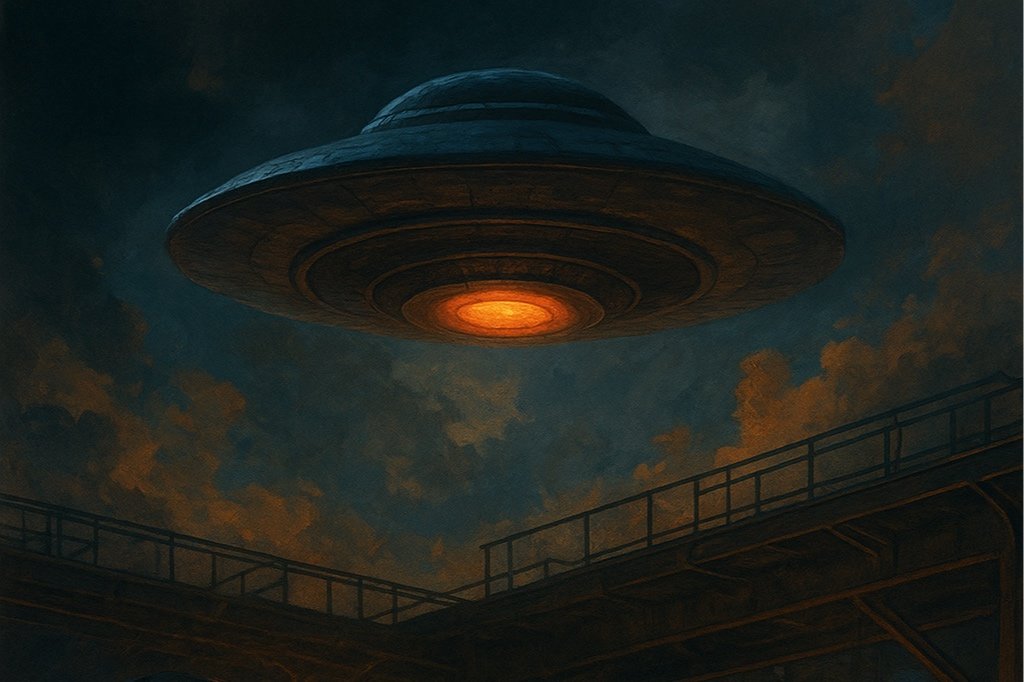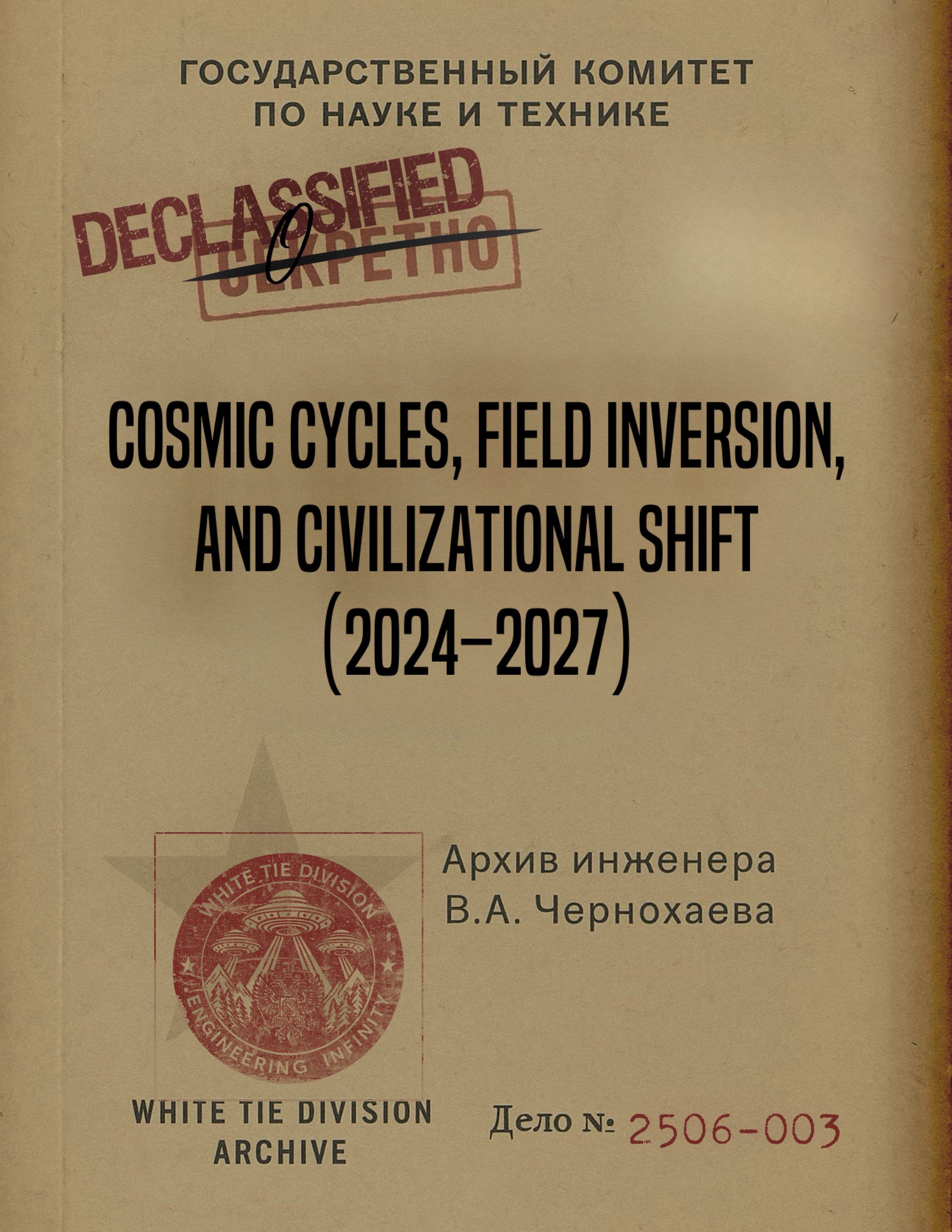Thank You For Your Donation!
The Extraordinary Science Behind
UFO Reverse Engineering
Engineering Infinity is not just a scientific manuscript. It is a reverse-engineering manual from the Cold War era that decodes the functional architecture of an unidentified flying object. Written in the 1980s by Soviet aerospace engineer Valerijs Černohajev, this document integrates highly advanced scientific principles with real-world engineering intent. Each topic within Engineering Infinity addresses a concrete functional challenge faced in assessing UFO performance. What might appear as abstract physics is, in fact, a subsystem blueprint. This is science in the service of engineering, and engineering in the pursuit of full disclosure.
1. Energy Source Identification
Water-Based Thermonuclear Fusion: Direct current generation using D+D reactions, unique plasma ignition models
Plasma Containment: Piston-based ignition chambers and toroidal magnetic systems
MHD Integration: Magnetohydrodynamic generators transforming plasma flow into electrical energy
2. Lift and Thrust Generation
Solenoid-Based Propulsion: Axial coil designs to create directional thrust fields
Magnetic Lift Systems: Anti-gravitational movement via magnetic induction
Field Geometry Control: Inertial neutralization through real-time vector modulation
3. Mass and Inertia Manipulation
Gravitational-Charge Dualism: Resonance-based unification of gravity and EM fields
Inertial Dampening Mechanisms: Dynamic mass reduction using charge-field modulation
Field-Induced Inertia Control: Manipulation of mass-density zones within the craft
4. Structural Stability and Containment
Toroidal Field Shells: Stabilization via internal field loops
Superconductive Layering: Sustained field density without material breakdown
Electromagnetic Field Envelopes: Structural and navigational cohesion
5. Material Behavior Under Extreme Conditions
Hull Composition: Engineered alloys with high dielectric response
Optical and Electromagnetic Cloaking: Frequency-tuned materials for visibility suppression
Crystalline Lattice Structures: Energy-responsive self-healing capabilities
6. Cosmic Navigation and Field Integration
Solar System Field Mapping: Real-time inertial adaptation based on planetary field shifts
Galactic Field Prediction: Use of Orion Arm magnetic harmonics to chart travel routes
Gravitational Navigation Models: Non-inertial trajectory calculation using external fields
7. Consciousness–Craft Interface
Tripartite Consciousness Model: Operator-field synchronization through cognitive harmonics
Field-Responsive Control Systems: Interface theories suggesting intent-based navigation
Psychophysiological Integration: Merging biology with field-reactive systems
Why This Is Extraordinary
Every subsystem described predates similar U.S. patents and programs by decades
Each solution directly correlates to functional requirements of known UFO capabilities
Černohajev's work was not speculative: it was drafted with the precision of a military engineering effort
Engineering Infinity is the most comprehensive and technically grounded roadmap to UFO reverse-engineering ever made public.
This is not just what a UFO could do — it is how one might be built.

This edition of Engineering Infinity: Earth’s First Interstellar Blueprint is made available for educational and non-commercial use. All rights reserved unless otherwise indicated.
ASK INFINITY
Ask Infinity is a custom AI assistant trained on Engineering Infinity: Earth’s First Interstellar Blueprint.
You can ask it questions about UFO propulsion, water-based fusion, gravity manipulation, or any part of Černohajev’s work — and it will respond with answers drawn directly from the book, plus real-time context from modern disclosure reports.
Just type your question and hit enter.
No background knowledge needed — start anywhere.
As with all AI - be sure to cross-reference and verify answers. It sometimes doesn’t get it quite correct.
The evolution from $15B research investment (1980-2000) to $150B+ operational development (2025) represents the most significant technological leap in modern history. With HIGH confidence, the US has transitioned from exploratory research to operational interstellar propulsion development, with Space Command positioned as the primary operational entity.
— Advanced Propulsion Research Network: Comprehensive Analysis of US Government Programs

Reports & Analysis
Official Party Lines
Updated: 22 JUN 2025
-
Engineering Infinity is a curated translation of Cold War–era documents left behind by Valerijs Černohajev, a Soviet aerospace engineer. We published them to preserve this legacy and invite further exploration.
-
Valerijs Černohajev was a Soviet-trained aerospace engineer who worked in Kazakhstan during the Cold War, likely in or near government-controlled research zones. He was a highly intelligent man, deeply loyal to the Soviet Union even after its collapse, and disillusioned by the instability and economic hardship that followed.
These documents may reflect the life work of a brilliant but forgotten mind—someone who never gave up on the dream of Soviet scientific dominance, even when the system itself collapsed
-
They were sent by Černohajev to his daughter, Natalja, just before his death in 2019. Discovered shortly afterward, they were translated and analyzed over the following four years.
-
Several factors suggest a connection to serious research and hallmarks that they were produced within a structured classification system used by the USSR. These include the technical structure of the material (including colored paper classification systems), the use of Soviet-era scientific conventions, detailed engineering schematics based on observation, and references to advanced propulsion systems.
Černohajev's background as an aerospace engineer working in Kazakhstan— home to major Soviet aerospace and defense facilities, reports from family about his career which mirror someone working in highly sensitive government projects, and connections to senior USSR and Russian government officials, further supports this likelihood.
-
We consider this a living document. The translations were created using a blend of AI tools, human review/translation, and contextual research. While they reflect the original wording as accurately as possible, some terms are technically ambiguous or evolving. A revised edition is already underway to improve clarity and expand technical annotations as better information develops.
We recognize that certain phrases may require further clarification or refinement — particularly where meaning depends on broader engineering or physical frameworks not immediately apparent in isolated passages. Our goal is to improve semantic precision and ensure the clearest possible interpretation in those cases.
-
The translation team includes Natalja Černohajeva-Sticco (M.Eng.), who as a native Russian-speaker reviewed AI output for fidelity; Mario Fialho, who built the translation model; and Gene Sticco, a retired USAF intelligence professional who led verification and overall contextual research.
-
This edition is a public translation and curation of original documents, not a peer-reviewed scientific paper. There is no indication in the notes we possess of peer review at the time. Researchers are invited to engage with the material and conduct independent evaluations.
Our research indicates that “Peer Review” in the USSR was different from today’s standard practices and usually limited to reviews by superiors within the organization.
-
We’re presenting the work as-is, with transparency. It includes propulsion concepts and models that align with UFO-related descriptions, and schematic titles that are labeled as “The UFO.” The reader is encouraged to assess the material critically.
-
It’s both. The book functions as a preservation of a lost Cold War–era technical voice, while also presenting ideas that intersect with modern scientific inquiry. It is offered as a historical artifact with potential scientific value—not a finished theory.
-
Think of it as a technical time capsule. We invite curiosity, scrutiny, and collaboration, not blind belief.
-
Absolutely! We welcome thoughtful input from physicists, linguists, historians, engineers, and researchers.
Please email contact@engineeringinfinitybook.com if you'd like to get involved.
-
Yes! Future editions will be edited to include improved translations, expanded commentary, and integration of feedback from readers and technical advisors, along with advances in science.







